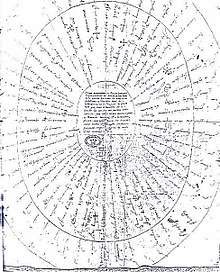Round-robin (document)
Round-robin is a document signed by multiple parties in a circle to make it more difficult to determine the order in which it was signed, thus preventing a ringleader from being identified.[1]
Origin

The term dates from the 17th-century French ruban rond (round ribbon).[2][3] This described the practice of signatories to petitions against authority (usually Government officials petitioning the Crown) appending their names on a document in a non-hierarchical circle or ribbon pattern (and so disguising the order in which they have signed) so that none may be identified as a ringleader.
This practice was adopted by sailors petitioning officers in the Royal Navy (first recorded 1731).
Spanish–American War
A round robin letter was authored in Cuba after the cessation of hostilities in 1898 by a committee of 10 brigade commanders of the American Army's V Corps including acting brigade commander Theodore Roosevelt during the Spanish–American War, to accelerate the departure of the American Army back to the United States during the rainy disease-plagued summer season. This letter was leaked to the press and embarrassed the administration of US President William McKinley.
References
- ↑ Online Etymology Dictionary: Round Robin
- ↑ Brewer, E. Cobham. Dictionary of Phrase & Fable: Round Robin
- ↑ Re: Round Robin, Oxford English Dictionary cited at The Phrase Finder, September 29, 2002